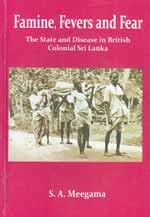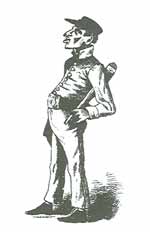Research scholars usually keep to the narrow confines of the subject of their interest. However, Dr. S. Ananda Meegama PhD, an internationally known demographer and statistician in his historically interesting publication ‘Famine, Fevers and Fear’ has gone further to study the challenges faced by persons concerned with the health sector of Ceylon.
| Bookfacts |
 |
Famine, Fevers and Fear’ The State and Disease in British Colonial Sri Lanka by S.A. Meegama. Reviewed by Upali Salgado
|
His exhaustive effort to examine the backdrop for patterns of mortality trends covering British colonial times in Ceylon, during the latter half of the 19th Century and in the 20th Century (up to about 1945) shows that at that time when communications were under developed, much needed finances from the colonial government at the centre were usually late. With few qualified medical men and others trained in health care to meet challenges when outbreaks of epidemics did occur, the ordinary people, and the country suffered economically. In that scenario, the indifference of the coffee and tea plantation overlords and the owners of large plantations who resided abroad to contain epidemics of cholera and smallpox was a major setback for the central government. The villagers themselves at that time were in fear of vaccinations, mainly because they were superstitious and uneducated.
Dr. Meegama has produced a large amount of valuable, interesting statistical information (demographic charts) after having had access to official reports released by Chairmen of Municipal Councils, District Medical Officers, Reports of the Census Department, Reports of Government Agents and Dispatches made by several Governors to the Secretary of State for Colonies, and also the Cholera Commissions Report.
Rapid population growth was plagued by problems of sanitation. The absence of pipe-borne water and effective systems for the disposal of human waste created veritable nets of infection from regular epidemics of cholera, dysentery and diarrhoea. South Indian migrant labour brought in to man the coffee plantations studded around Mathurata, Kandy, Matale and Nawalapitiya Districts brought cholera which spread like “wild fire” soon after the coffee bloom in 1870-1871. About 30 years later this disease together with the deadly smallpox spread enveloping much of the up-country tea plantations where sanitary conditions were deplorable. Indian labour lived in squalid conditions. Seeing the devastation and fall in numbers of labour wrought by smallpox, the colonial masters established hospitals in Colombo, Galle, Kandy, Trincomalee and Jaffna. They launched programmes of mass inoculation of people. These programmes of vaccination penetrated to the distant villages. The author records that in 1820 in Kandy 9020 people were treated for smallpox and 525 persons died. The Central Province had in 1870 a major outbreak of smallpox.
 |
| ‘Contagious Diseases Constable’-J.L.K. Vandort’s depiction |
Cholera first made its ugly appearance in1819. Two years later, the disease spread to the NW Province and in the Mannar District, one in six of the population died. In Jaffna there were 17 deaths in 1845 and by 1855 it rose to 6125 deaths. The cholera epidemic in 1866 virtually destroyed several villages in the Mannar District, where South Indian labour settled first, on arrival. This disease raised its ugly head quite often at Kataragama during the festival season.
A heartwarming and commendable feature was the dependence of the colonial Police service to cover public health. They erected temporary hospitals and helped transport the sick and the death. Another major cause of death till about 1940 was the spread of Malaria. It is known that when the Malaria epidemic was at its height between 1934 and 1936 the Central Government had imported over five tons of quinine tablets to contain the sickness. In work places many labour hours were lost.
Periodic outbreaks of typhoid fever due to poor water sanitation and breeding of house flies resulted in several deaths. Tuberculosis was another dreadful sickness due to malnutrition and because workers lived in crowded slums in the fast growing urban population. With the establishment of Sanitary Departments under local government authority, the appointment of Sanitary Inspectors who worked out of doors, was a major step forward in the right direction. The underground drainage system of Colombo was commissioned in stages between 1908 and 1913. Pipe borne water from the newly created Labugama Reservoir was a major achievement. Local Government authorities took steps to close night soil cesspits and prevent the spread of house flies.
The part played by politicians in the State Legislature that helped achieve better health standards, has also been dealt with. As from 1931, after Ceylon obtained universal adult suffrage the subject of health care came under a Central Government Minister, resulting in adequate funds being provided in the annual Budget. Several key figures of the time who took an interest in matters of health in the Legislature were Dr. W. Arthur Silva (Minster of Health), George E. De Silva, D.A. Rajapakse, Dr. S. A.
ickremasinge, Philip Gunewardena and Dr. N.M. Perera. Consequently between 1945 and 1948, the number of hospitals established increased from 153 to 246. Further, many dispensaries were established, on tea plantations and in rural areas. Under the supervision of District Medical Officers the spraying of DDT was done islandwide on a regular basis.
Dr. Meegama’s note of appreciation to philanthropists includes who were concerned with public health. They were Charles Henry de Soysa of Moratuwa, who founded the de Soysa Maternity Home and the Lunawa Hospital; J.W. De Soysa who established the Bacteriological Institute, Mudaliyar Samson Rajapakse of Balapitiya who gifted land to establish the Medical College, and A. E. (later Sir) de. Silva of Ratgama who gifted land at Kandana in 1903 for the TB Hospital.
Dr. Ananda Meegama is to be commended for his monumental work which educates us today on a forgotten subject. His scholarly work will surely find a place in many a library. |



